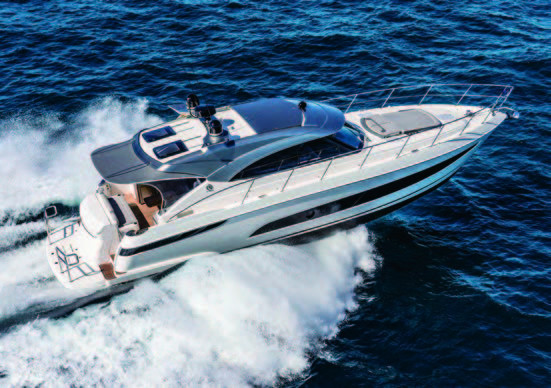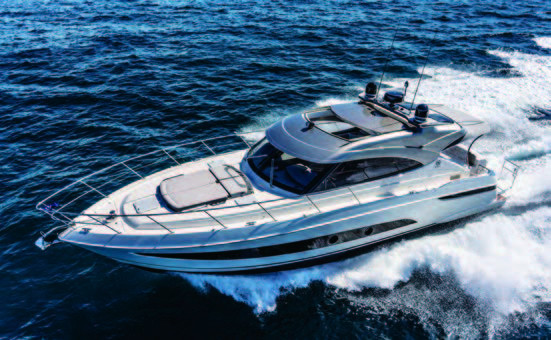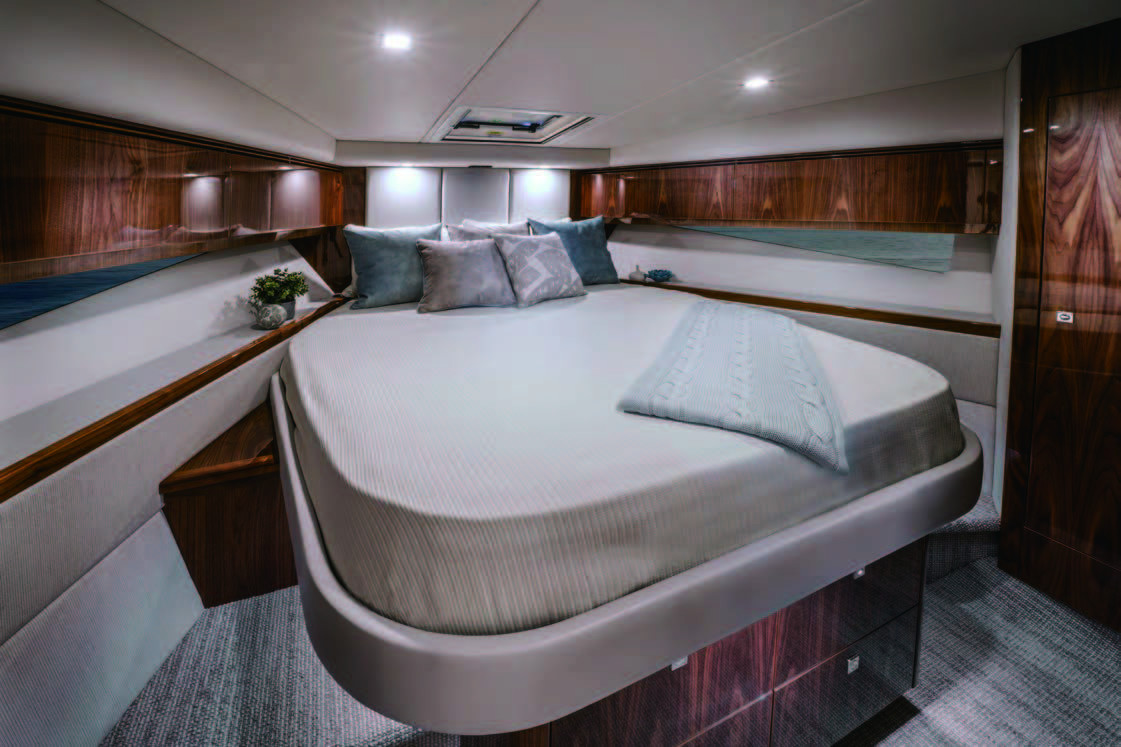Adding a meaningful new layer of refinement to already slick performers is quite an achievement for Australia’s premium marque, Riviera.


Adding a meaningful new layer of refinement to already slick performers is quite an achievement for Australia’s premium marque, Riviera.
The Riviera 4800 Series II thrives in the fast lane, reaching 34 knots with ease during a sea trial on a bumpy Sydney Harbour.
SYDNEY INTERNATIONAL BOAT SHOW in August was an ideal place to experience Riviera motor yachts. The prolific builder had brought an impressive armada, so the relative scale of their most popular models – the towering flybridge cruisers – could be measured in relation to their in-vogue new Sport Yacht launches, comprising the 4800, 5400 and 6000 models. These single-level compact yachts embody much of what the modern boater seeks nowadays, so revamping them with the latest materials and systems made a lot of sense, explained company owner Rodney Longhurst as we viewed his yard’s latest creations. Decked out in grey livery on their topsides with even the teak deck caulking done in grey, all were well framed by the show’s Sydney CBD backdrop.

Apart from a double sunpad, the foredeck on the 6000 and other models all feature quality Muir windlasses and premium Ultra anchors.
With three to choose from, one is reviewed in detail here and the other two follow briefly to compare with it. The 4800 came with more changes to merit a renaming to the 4800 Series II. Contrasting with the 63-foot (19.2-metre) 6000, a superyacht in many ways – including crew quarters and full-height engine room access – the 4800 has wider appeal, given its manageability and affordability. Slotting in-between, the 5400 comes with three large cabins and a second saloon space.

Sports cruiser merits
Sports cruisers offer both the versatility and performance ideal for coastal blasting or weekend decadence, which is something that Riviera has been offering with aplomb for three decades – featuring dinghy garages, large aft decks and airy interiors. Offshore, their low-profile hulls are more stable than towering flybridges which require you to brace continually in a swell. The 4800 Series II, with two double cabins is a manageable package for a couple of people to have fun on. Powered by well-proven Volvo IPS pod drives that are great at low speed or at the 30-knot maximum, this model is very much a driver’s boat. Built to offshore standards, they have a deep V-hull and in the case of the Riviera 4800 Series II, a sturdy build with substantial keel and watertight bulkheads for rigidity in swells.

The aft deck is spacious and abounds with practicalities such as dinghy garage and a new Platinum double barbecue.
Redefined cockpit
The entry-level 4800 Series II shares the same sleek aesthetic as the larger models. The 45-foot (13.7-metre) hull reaches nearly 52 feet when the bowsprit and Platinum Edition extended hydraulic swim platform are considered. The swim platform is also a private perch at anchor and of course a quay when the garage door is electrically opened to reveal the eight-foot, 10-inch (2.7-metre) dinghy. Stepping up to the aft deck reveals the portside wet bar which now has a Platinum double barbecue. To starboard is an adjustable table that becomes a sun pad, with lounge bench tucked aft. Riviera prides itself on creating large cockpits with encompassing sun protection via the fibreglass bimini; for 2019, the Platinum finish is now tough Sunbrella fabric instead of vinyl throughout.

I found good ergonomics at the helm, with throttles, tabs and joystick controls all easily to hand, while key data was clearly displayed on 12 inch Volvo/Garmin Glass Bridge screens.
The cockpit flows into the saloon through a sliding stainless-steel door, past the portside galley. Ahead of this is the steering console with lounge offset to starboard. Low-set furniture allows emphasis on surrounding windows and for that alfresco touch, click open the sunroof. On sports cruisers, visibility is particularly important to the skipper, and in my backyard of Sydney Harbour it’s essential if stress levels are to be kept down, rather than continually asking your partner to be a spotter. So the tall saloon windows and opening side ones are useful. The offset port console does lack the visibility found on the centreline-mounted 5400 but there’s not much in it. At the dashboard, screens are shaded by a fibreglass outside lip. Being seated in the leather Recaro electric seat with new Platinum diamond-quilted Alcantara inserts, reminds me of a Bentley I was recently in as did the console’s leather fascia. It’s dominated by two 16-inch Garmin Glass Bridge screens with another small one for the CZone domestic system, which uses simple menus to digitally control and quickly fault-check everything. Separate engine management is done via a dedicated Volvo EVC screen/system. This Electronic Vessel Control system is similar to Czone in being a digital backbone and as a separate system; it avoids the 4800 Series II having a single point of system failure.

The open plan layout is modern and comfy with aft galley and views all round from both dinette and the helm.
Engine controls sit along the left side with IPS joystick, throttles and autopilot all comfortably reachable. In addition, the joystick outside in the aft cockpit is ideal for close manoeuvring of the 4800 Series II, as I experienced when leaving the confines of the Sydney Superyacht Marina. Our review boat came with Volvo Trim Assist auto tabs (with manual override) to adjust heel angles and Volvo’s DPS (Dynamic Positioning System) – the latter ideal for holding position near a fuel berth and other tight spots. Another useful new Platinum Edition feature is the Garmin-Volvo heading control on the helm, a notched way of steering instead of using the full autopilot – useful offshore. In addition, the Platinum grey overhead fibreglass gantry houses radar, aerials and there’s room for a satellite receiver so you can fit the Dock Unattended system for remote system checking.

The saloon’s uncluttered layout belies a functional space. The elevated lounge/dinette seats six easily while giving panoramic views; its walnut cabinetry contrasts stylishly with the oatmeal-coloured Platinum Sunbrella furnishings, and perishables are stored in cold drawers behind the lounge. The U-shaped galley adjoins the aft cockpit. Twin electric Smeg hotplates are at the aft window with microwave underneath. Forward is a deep sink with chest fridge and there’s a slot for a dishwasher beneath. My only gripe is the lack of fiddles in what is an otherwise slick galley that also includes deep cupboards with Riviera’s crockery. Spillage or wet feet aren’t a problem: underfoot is hard-wearing Platinum synthetic wood-effect laminate, which I’ve seen used on other premium boats as it’s robust and grippy. For entertainment, a Fusion stereo is near the aft door and a pop-up flatscreen television forward.
The finish throughout is superb, ranging from the 316 stainless steel doors to the impeccable high gloss cabinetry that showcase Riviera’s in-house craftsmanship.

The owner’s ensuite forward is airy with a tall queen-sized bed, large opening skylight; and has the advantage of being far from the engines.
Underdeck lounge
Two large cabins and two bathrooms are below, with the underdeck lounge ensuring privacy between the forward owner’s area and midships VIP cabin. Customisation can reduce the lounge size for a larger VIP cabin. The airy lounge is ideal for watching the integrated flat-screen TV without glare. Cupboards throughout the corridor and elsewhere in the 4800 Series II ensure that this boat can easily cope with holiday cruises, and underfoot is the same hard-wearing wood-effect laminate as in the saloon, with Australian wool carpets reserved for the cabins.
The wide flared bow benefits the master cabin, allowing ample walking space around its queen-sized island bed. Thanks to the pod drives no thruster lurks beneath to disturb, instead there’s plenty of storage. The necessity for ventilation in the tropics is something Riviera is well aware of so there’s a large opening skylight and portlights. The soft-close cabinetry moves easily, which is testament to the in-house joinery team, and is smoothly finished with sturdy metal fixings. Other quality features include cedar-lined wardrobes and matching grain exteriors. Practicalities abound, with hatches behind cupboards for electrical access, neutral-coloured headboards that won’t be difficult to clean and there’s a large separate shower.
The VIP cabin uses the full 15-foot (4.6-metre) beam of the 4800 Series II to create ample space for the three adult-sized beds, with the two portside beds electrically joined when required. There’s standing headroom on entry and abundant natural light from the rectangular portlights with opening portholes. Both bathrooms have been given the Platinum touch and so have new vanities and synthetic tile-effect flooring. The VIP bathroom is in the corridor, so doubles as the day head and is similarly laid-out with separate shower. Its linen cupboard has a convenient bi-fold door that conceals the optional washer-dryer. Good features include portlights and skylights for ventilation. Efficient shower drainage is typical of the detailed Riviera approach, as is the electric Dometic head, fitted as standard.

The VIP cabin uses the full 15-foot beam and is midships so has the least motion at sea.
Gyro-ready hull
The Platinum Edition hull changes allow a Seakeeper gyro to be factory-fitted to ward off mal de mer. The topsides combine stylish aesthetics with practicalities, such as sturdy handrails (316 stainless-steel throughout) and thick teak underfoot in the aft cockpit. Also underfoot is the dinghy garage. Simply submerge the hydraulic platform with a button click, then open the large electrical door to launch the dinghy. Should you need to anchor beforehand, this is also well taken care of with wide decks guiding you to the sizeable Muir vertical windlass/capstan at the pulpit with its hefty Ultra anchor. The full bow allows for a wide double sun pad here as well, with backrests and a handy pull-up bimini for shade.
The inside of the hull has been optimised for pod drives’ positioning to minimise spray and add volume. The hand-laid fibreglass build is solid GRP below the waterline and cored above, including the deck, for insulation and lightness; and the 4800 Series II has reasonable power-to-weight ratio given its 18.5-tonne displacement. Hull rigidity comes from a solid GRP keel with hard chines and deep bilges where tankage is placed to aid stability. The lustrous exterior comes from two coats of epoxy undercoat while underneath are double coatings of premium quality anti-foul paint.

Pod manoeuvrability
Traditional power boaters may groan when confronted by the forward-facing propellers of the Volvo IPS pod drives, as opposed to the backward-facing design of competitors Cummins Mercruiser Zeus and ZF Marine. But nowadays these Volvo engines are the well-proven market leader, and Riviera has installed them in about 1,000 boats. The IPS contra-rotating twin propellers on each drive operate in relatively undisturbed water to maximise thrust, which does leave them vulnerable to debris or lobster pot lines but they feature inbuilt line cutters. Opening the large aft deck hatch and climbing down the ladder brings me face-to-face with the twin 600-horsepower six-cylinder Volvos and IPS-800 gearboxes. The engine room layout has filters conveniently on the centreline and ample walking space between engines, while the Onan generator is also on the centreline aft which reduces noise. Power controls for the 24 Volt electrics are both here and in the cockpit. Batteries are just above bilge level for stability.

Comfortable on the Recaro chair, we motored against the breaking swells coming from around Sydney Harbour Bridge.
Stormy Sydney
Clearing the dock in strong crosswind is challenging and the optional cockpit-mounted joystick is ideal for watching the topside as you gently manoeuvre, pushing the joystick in the desired direction and holding it to increase power. Once clear of the Superyacht Marina we made our way out to a stormy Sydney Harbour where one-metre waves and 25-30 knot westerly winds buffeted us. A winter day only fit for keen yachting journalists concluded as I steered us into the swells, waves breaking over the bows. At the wheel, the Recaro electric seat absorbed the bumps while a quiet growl came from the 600-horsepower Volvos as I stirred them into action to propel us down Sydney Harbour to beyond Bradley’s Head for some shelter and speed.

Effortlessly getting on the plane at 16 knots and cutting some S-turns, I sped up to a 25-knot cruising speed. Turning side-on to the swell showed stability to be good, which gave me confidence to then run with the waves; the auto trim did its job of flattening the bow, allowing me to simply enjoy the drive. Feeling even more at home at the helm I glanced at the instrumentation that clearly showed the key data. The analogue LCD readouts on the Volvo screen indicated 2,500 RPM and fuel consumption of a 156 litres per hour as we slid over the waves at 25 knots; giving a range of 338 nautical miles. For the final test of a sports cruiser – breaking the 30 knot barrier – the rough seas weren’t good. So with an anxious company rep looking on, I put the throttles fully down, forcing the grey-topped hull forward, the Harbour Bridge growing larger in my view as the numbers rose to 30 then 35 knots. At this speed you pay for your fun, with the diesel tank emptying at 246 litres per hour. Well, at least you’ve got it if you need it, I thought, before throttling back to cruising speed of 25 knots.
www.rivieraaustralia.com

The 5400, powered by two 725-horsepower Volvo IPS, easily breaks the 30-knot sports yacht barrier.
RIVIERA 5400 SPORT YACHT PLATINUM EDITION
The 57-foot Riviera 5400 Platinum has all the finishes found on the 4800 Series II but has an additional third double cabin option. A big differentiator from the 4800 Series II is a full-beam master suite, deep in the hull, with a king-size bed and en-suite bathroom. The VIP stateroom fills the forepeak, while there is a choice between a lower lounge or twin-bunk cabin. The saloon has a spacious U-shaped galley which even includes bar stools with a drinks ledge.

The centreline steering console is something I also like at sea on the 5400, with a second lounge alongside it. The larger hull is more sea-kindly than the 4800 Series II, not forgetting the more powerful 725-horsepower Volvos that propelled me to a top speed of 35 knots while cruising happily at about 26 knots for a range of about 380 nautical miles, so it’s ideal for those long offshore legs.

The 63-foot 6000 has crew quarters.
RIVIERA 6000 SPORT YACHT PLATINUM EDITION
The 6000 is the superyacht of this trio – not simply because of its 63-foot length (19.3 metres) and 27 tonnes, which meant it coped so much better than the other boats at 25 knots in steep seas – but also due to its palatial feel and features. Big-boat features include a walk-in engine room with crew berth alongside it and spacious accommodation throughout that sleeps eight to 10.

A large aft deck for entertaining along with large dinghy garage make the 6000 a worthy flagship of the Sport Yacht range.
The owner enjoys a full-beam stateroom which is enlarged if the option for the longitudinal bathroom placed forward is chosen. Guests have two other large cabins to choose from, with a large underdeck lounge to relax in. The 6000 has the same twin 725- horsepower IPS Volvos as the 5400 but tankage is increased to 3,300 litres.

PHOTOS: RIVIERA; KEVIN GREEN























